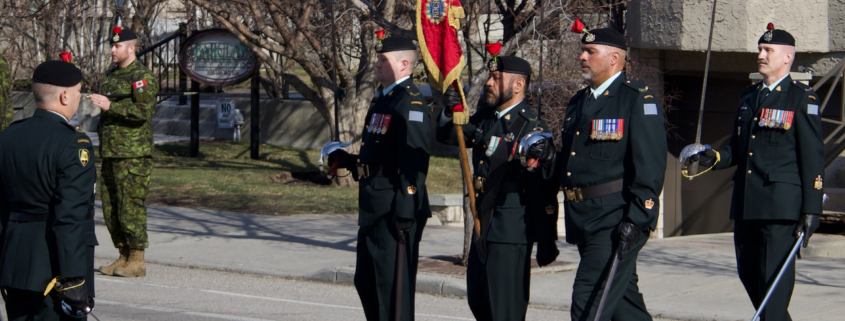The Significance of the Guidon
Every military unit has a flag which identifies it, is symbolic of that which it represents, and ties in with the unit’s history and battlefield accomplishments. This flag is most often referred to as a standard or colour, and is proudly displayed with a guard during ceremonial events.
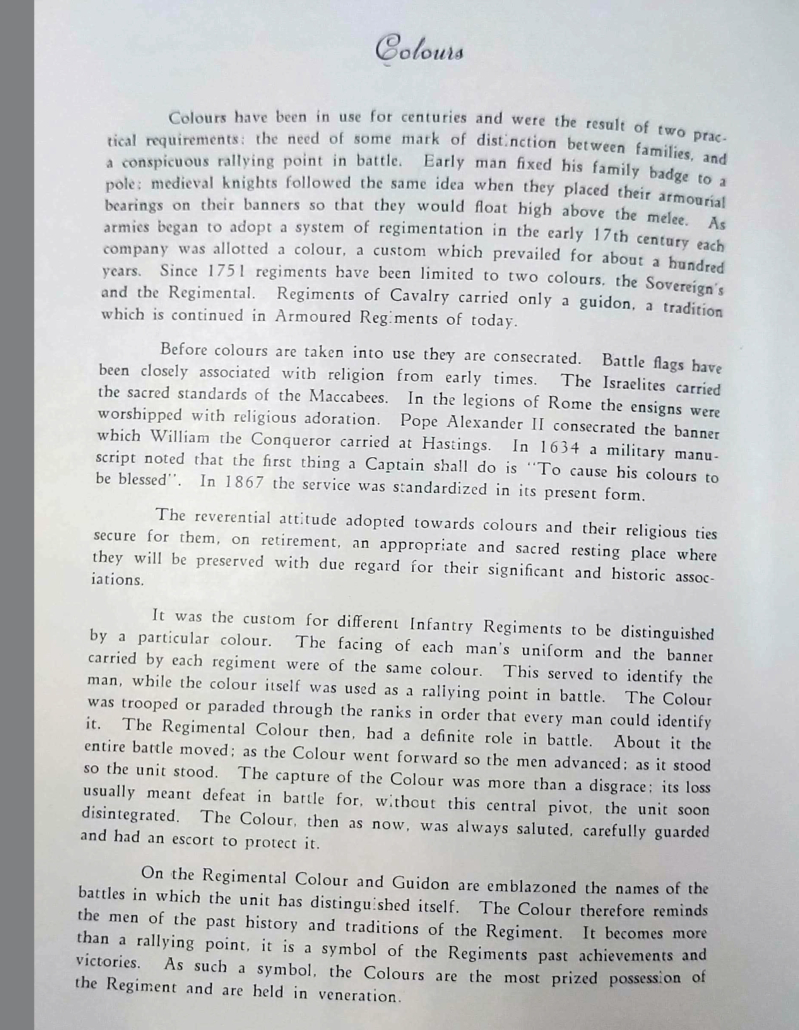
In the Armoured Corps in Canada and many other countries, however, this flag is called a guidon, and is a different size and shape than other military colours.
The word guidon has roots predominantly in French (guidon) and Italian (guidone and guidare), words meaning “battle standard” and “guide”.
With riders in traditional Cavalry formation – two abreast on horseback – the guidon was borne by the man on the front right of the formation. This guide, or guide-man, was who the unit would follow into battle so that they would know where to go. Though not used by all historic cavalry units, the swallowtail shape for the guidon became common due to travel by horseback.
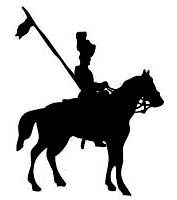
In Canada, a guidon displays up to 21 battle honours held by the unit. Any remaining battle honours may be listed on the baldric of the guidon bearer or drum major, the Regimental drum, or the mace carried by the drum major.
Many characteristics of Canadian guidons are regulated. These include the height of the pike upon which the guidon flies, the size, shape, and general layout of the emblems on the fabric, and the ciphers.
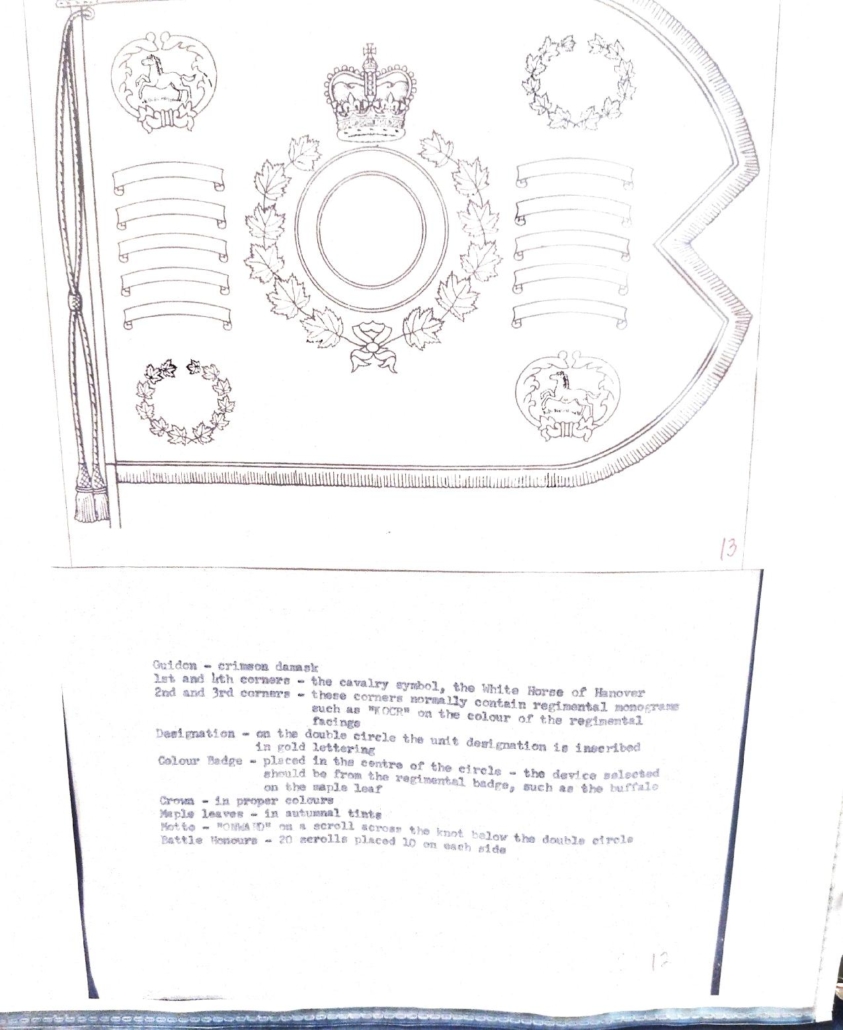
The emblems in the middle and sides are afforded some choice by the unit, but specific emblems must go in the four corners. In the corners of the King’s Own guidon are two emblems which herald the infantry and armoured roots of the unit: the white horse of Hanover, and the ram from the family crest of General Worthington, named as the first Armoured Corps Commander.
The guidon is affixed to the pike by a cord, and the crown of the pike is usually the Governor General’s insignia: a lion wearing a crown and holding a maple leaf, however, the King’s Own have retained the British lion, which does not hold a maple leaf.
The King’s Own’s guidon is one of the oldest in Canada. During Her Majesty Queen Elizabeth II’s first visit to Canada following her Accession in 1952, she presented the King’s Own with the guidon that is still in use today. A joint parade took place on July 17, 1959, with the PPCLI (to whom she also presented new colours) at Beacon Hill Park in Victoria, BC. Read more about that historic event here. At the time the guidon displayed 20 battle honours.
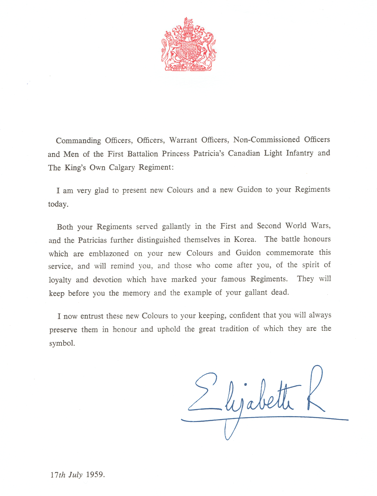
Scan from the King’s Own Museum Archives.

Presentation of the Guidon of the King’s Own Calgary Regiment
and the Colours of 1 PPCLI at Beacon Hill, Victoria BC.
📷 Department of National Defence, provided by the King’s Own Museum Archives.
In the spring of 2022, the guidon was updated to reflect the unit’s involvement in southeast Asia, and the Afghanistan theatre honour was emblazoned in the remaining space allotted for battle honours.
The battle honours now displayed on the King’s Own guidon are as follows:
- Ypres 1915, 17
- Ancre 1916
- Vimy 1917
- Amiens
- Canal du nor
- Dieppe
- San Leonardo
- Gustav Line
- Trasimene Line
- Italy 1943-49
- Festubert 1950
- Arras 1917, 18
- Passchendaele
- Drocourt-Queant
- Valenciennes
- Sicily 1943
- Cassino II
- Liri Valley
- Arezzo
- Northwest (N.W.) Europe 1942, 45
- Afghanistan
Historically a unit’s guidon is kept on display in the Officers’ Mess, however, the King’s Own unit tradition is different. On the day of presentation, King’s Own Commanding Officer LCol. Alex McIntosh directed the Regimental Sergeant Major (RSM) to take care of the guidon, and thus it remains to this day. The King’s Own is the only unit in the Royal Canadian Armoured Corps where the RSM is the custodian of the guidon: it is kept in the RSM’s office. For ceremonial events, the CO orders the guidon on parade; the RSM sees this through personally, and falls in on the parade behind the guidon.
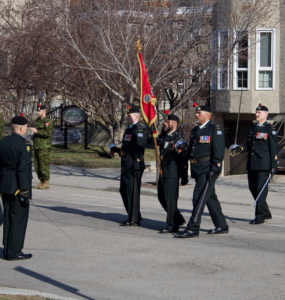
CO: LCol Watts (forward of Guidon)
WO Fensom, WO Fernandez, WO Denson
RSM: CWO MacGillivray
📷 G. Monforton
Onward!
Many thanks to the King’s Own RSM Troy MacGillivray for sharing his extensive knowledge of unit and military history, and the history of the King’s Own guidon, as reference for this article.
Sources referenced:
- https://www.merriam-webster.com/dictionary/flag
- https://www.merriam-webster.com/dictionary/guidon
- https://www.etymonline.com/word/guidon#:~:text=guidon%20(n.),%2D%20%22to%20see%22).
- https://www.canada.ca/en/department-national-defence/services/military-history/history-heritage/official-military-history-lineages/customs-traditions/flags-colours.html
- https://www.canada.ca/en/department-national-defence/corporate/news/regional-news/western-sentinel/2022/05/the-kings-own-add-the-afghanistan-theatre-honour-to-their-guidon.html

